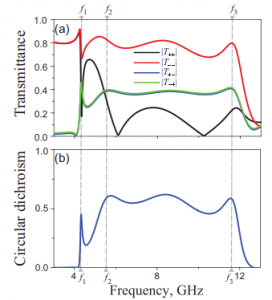 In a paper entitled “3D-Printed Chiral Metasurface as Dichroic Dual-Band Polarization Converter,” a team of researchers discusses designing a 3D chiral metasurface behaving as a spatial polarization converter with asymmetric transmission.
In a paper entitled “3D-Printed Chiral Metasurface as Dichroic Dual-Band Polarization Converter,” a team of researchers discusses designing a 3D chiral metasurface behaving as a spatial polarization converter with asymmetric transmission.
“The metasurface is made of a lattice of metallic sesquialteral (one and a half pitch) helical particles,” the researchers explain. “Each particle contains six rectangular bars arranged in a series one above the another creating a spiral. The proposed metasurface exhibits a dual-band asymmetric transmission accompanied by the effect of a complete polarization conversion in the response on the particular distributions of currents induced in the particle’s bars by an incident wave. Regarding circularly polarized waves the metasurface demonstrates a strong circular dichroism.”
An optical diode, the researchers continue, is a device transmitting light in one direction and blocking it in the reverse direction. Among various types of optical diodes, one well-known example of this non-reciprocal response is “the magnetooptical (Faraday) effect related to circularly polarized light propagating in gyrotropic materials.”
“The biased magnetic field breaks the time-reversal symmetry, which leads to a nonreciprocal response of media,” the researchers state. “This mechanism is accompanied by the effect of circular dichroism related to differential absorption of the left-handed and right-handed circularly polarized waves. However, the nonreciprocal response is not restricted to the use of magnetic field only. Indeed, optical diodes can be constructed by utilizing spatial-temporal modulations of refractive indices or some nonlinear effects for which the reciprocity theorem is violated.”
Alternatively, they add, an asymmetric transmission can be realized in chiral artificial structures, or metamaterials, even when they are completely reciprocal. There are limitations to chiral metamaterials based on 2D planar technologies, however. The first limitation is related to their electromagnetic properties, considering that a complete asymmetric transmission is a resonant feature strongly dependent on dissipation. The second limitation is that commercial glass epoxy laminates cannot provide mechanical support of metallic patterns at extremely high temperatures, which restricts their application area.
 The researchers discuss the design of a 3D chiral metastructure using 3D printing from a metallic alloy, namely cobalt chromium. Because the alloy has a high melting temperature, it can prevent the metasurface structure from being destroyed in an extreme working environment. This is a unique advantage of the alloy-based metasurface compared to the chiral components patterned on glass epoxy laminates. The researchers demonstrated a dual-band asymmetric transmission feature as well as a strong broadband circular dichroism in the proposed metasurface, both theoretically and experimentally.
The researchers discuss the design of a 3D chiral metastructure using 3D printing from a metallic alloy, namely cobalt chromium. Because the alloy has a high melting temperature, it can prevent the metasurface structure from being destroyed in an extreme working environment. This is a unique advantage of the alloy-based metasurface compared to the chiral components patterned on glass epoxy laminates. The researchers demonstrated a dual-band asymmetric transmission feature as well as a strong broadband circular dichroism in the proposed metasurface, both theoretically and experimentally.
“We argue that a complete polarization conversion can be reached by solving a geometrical optimization problem for the required frequency band,” the researchers conclude. “In such a way, our work paves the way to find an industrially high-temperature component solution on polarization conversion an separating communication channels utilizing features of the linear asymmetric transmission and strong circular dichroism at microwaves as well as at higher frequencies.”
Authors of the paper include Shengzhe Wu, Su Xu, Tatiana L. Zinenko, Vladimir V. Yachin, Sergey L. Prosvirnin and Vladimir R. Tuz.
Discuss this and other 3D printing topics at 3DPrintBoard.com or share your thoughts below.
Subscribe to Our Email Newsletter
Stay up-to-date on all the latest news from the 3D printing industry and receive information and offers from third party vendors.
You May Also Like
Profiling a Construction 3D Printing Pioneer: US Army Corps of Engineers’ Megan Kreiger
The world of construction 3D printing is still so new that the true experts can probably be counted on two hands. Among them is Megan Kreiger, Portfolio Manager of Additive...
US Army Corps of Engineers Taps Lincoln Electric & Eaton for Largest 3D Printed US Civil Works Part
The Soo Locks sit on the US-Canadian border, enabling maritime travel between Lake Superior and Lake Huron, from which ships can reach the rest of the Great Lakes. Crafts carrying...
Construction 3D Printing CEO Reflects on Being Female in Construction
Natalie Wadley, CEO of ChangeMaker3D, could hear the words of her daughter sitting next to her resounding in her head. “Mum, MUM, you’ve won!” Wadley had just won the prestigious...
1Print to Commercialize 3D Printed Coastal Resilience Solutions
1Print, a company that specializes in deploying additive construction (AC) for infrastructure projects, has entered an agreement with the University of Miami (UM) to accelerate commercialization of the SEAHIVE shoreline...






























